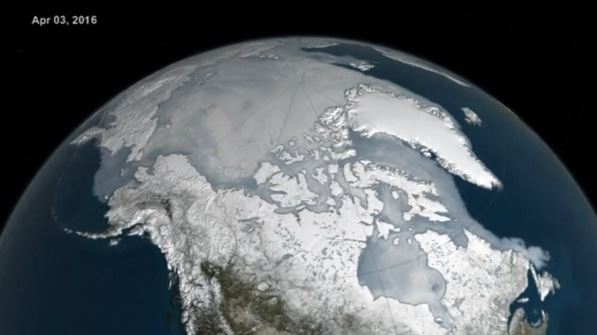
(REUTERS) Record-breaking warm temperatures in the first half of 2016 have primed the Arctic for another summer of low sea ice cover, said NASA on Friday (August 19).
“Globally it’s been the warmest year on record,” said NASA scientist Walt Meier from Goddard Space Flight Center in Greenbelt, Maryland “That’s resulted in an earlier melt of the Arctic sea ice and an opening of the ocean. And so we’re on track for one of the lowest sea ice years on our satellite record and one of the lowest minimums which will reach in mid-September.”
Sea ice is frozen ocean water around the polar caps, and is important because it “acts like a refrigerator for the global climate system,” keeping the Arctic region cool, says Meier.
Over the past three decades, Arctic Sea ice has dramatically declined; making what was once extraordinary low measurements the new normal.
“As we’re losing the ice, as we’ve been seeing over the previous decades and especially in recent years, we’re replacing that with the dark ocean that absorbs all that energy and the ocean heats up and the whole Arctic heats up, and basically it’s like we’re opening up the refrigerator door so the Arctic’s cooling mechanism is becoming less and less efficient as we lose the sea ice,” said Meier.
But the region is warming twice as fast as elsewhere in the world, making the Arctic one of the most visible signs of a changing planet.
“The Arctic is connected to the rest of the climate system, said Meier. “The Arctic is not like Las Vegas. What happens in the Arctic doesn’t stay in the Arctic.”
Meier explained warming of the Arctic is changing the balance between the cold Arctic and the lower latitudes that potentially changes weather patterns.
“We already seeing evidence of that in terms of how the jet stream is changing,” said Meier. “It’s becoming less of a west the east flow and more of a loopy flow kind of more north to south which leads to more extreme events things like droughts things like torrential rains and flooding.”

Global warming has been one of the issues discussed in the U.S. presidential campaign, with the democratic nominee Hillary Clinton seeing it as an immediate concern, while her Republican rival Donald Trump, dismisses the issue as minor.
Meier said he prefers to ignore the politics.
“I’m of course interested in the consequences as a citizen and concerned,” said Meier. “But my role as a scientist here at NASA is to kind of really dig into the science, dig into the data, and the satellite data and understand what’s going on.
“That’s where I feel like myself and NASA in general provides the greatest benefit to society.”
Meier said in 2018, NASA will launch the ICESat-2 satellite which will be taking some of the most advanced measurements of the polar regions to date.







